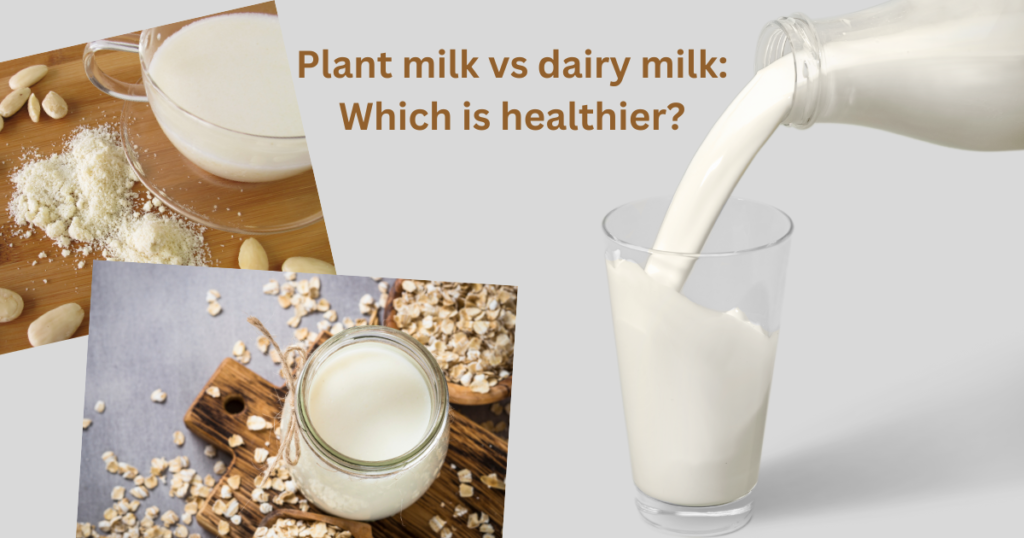Alternative milks have gained massive popularity in recent years. An obviously welcome option for vegans and people with lactose intolerance, it didn’t take long before health claims appealed to other people too.
Now they’re a regular staple in people’s coffee and cereal, often on the assumption that they’re healthier and better for us.
But as we’ve covered before, ‘plant-based’ doesn’t necessarily mean ‘healthy.’
More often than not, it’s a highly-processed ‘near food object.’
A quick overview of plant milk
Non-dairy ‘milk’ is a surprisingly ancient food — some of the earliest plant milks date back to the 8th century and earlier. Of course, the types and consistencies of plant milk today look nothing like their predecessors. They’re far more processed than their earlier examples.
There are now four major types of plant milk on the market:
- Almond milk
- Oat milk
- Soy milk
- Coconut milk
You may also see alternatives like flax milk, rice milk, and cashew milk, but these are typically more expensive and less widely available.
Plant milk is quickly growing in popularity: approximately 10% of the US milk market consists of plant-based alternatives. And with as many as 44% of American households consuming plant milk every day, we need to ask the question — is it actually good for you?
The problems with plant milk
Plant milk isn’t the superfood most major food corporations make it out to be.
Depending on the ingredients label, it could be disastrous to your metabolic health.
Here’s the unbiased truth you need to know about plant milks — starting with their biggest problem:
Highly processed
Between 90% and 95% of plant milks are considered ultra processed foods. They also contain problematic ingredients:
- Binders such as dicalcium phosphate, which may play a role in calcifying organs
- Thickening agents such as guar gum, which may have a link with inflammation
- Preservatives and stabilizers such as carrageenan, which links to inflammatory bowel diseases
It is possible to find minimally-processed plant milk for sale, but again, this is just 5% to 10% of the market.
Seed oils
I’ve written quite a bit on vegetable and seed oils, so I won’t spend too much time on them here. To summarize succinctly, seed oils are disastrous to your metabolic health. Not only do they worsen symptoms of inflammation, but they unbalance your ratio of omega 6 to omega 3.
At most, humans should consume an omega 6 to omega 3 ratio of around 4:1. Seed oils and vegetable oils disrupt this balance. Some seed milks come with ratios up to 235:1 (compared to whole cow’s milk at a ratio of 2 or 3:1).
Possible toxins
Toxins exist in almost everything these days, but plant milks come with a uniquely dangerous profile.
Oat milk, for example, can contain trace amounts of Roundup. Studies link glyphosate exposure with cancer, heart disease, and hormone disruption.
Researchers have also discovered a larger concentration of heavy metals in plant-based milk compared to cow’s milk. This may not be true of every sample, but it’s certainly worth your consideration.
Endocrine disruption
I’m sure you’ve seen studies linking soy milk to hormone imbalances. There’s been quite a lot of contention here, particularly since many studies focus on animals rather than people.
That said, ongoing studies continue to find concerning evidence between childhood soy intake and proper hormonal development. The traditional consumption of soy in the East was primarily for adults. With soya infant formulas in the West, childhood exposure is now increasingly high.
The biggest villain here is glyphosate, which is the primary pesticide for soya crops. Studies show Roundup interferes with human hormone production and alters hormone receptor expression, which can negatively impact your epigenetics.
Less protein
Nutritionally-speaking, plant milk is not a one-to-one substitution for dairy. There may be some artificial fortification, but you’re not going to see the same results.
There a several differences worth pointing out:
- The fat content is different. Plant milks typically contain monounsaturated PUFAs, while dairy milk contains saturated fat. And as we know, low-fat diets can be disastrous for your health.
- The protein content is different. An eight-ounce glass of dairy milk contains eight grams of protein. There’s just two grams of protein in a similar glass of plant-based milk. This is interesting, considering some studies suggest most Americans don’t get enough healthy protein.
- The sugar content is different. Whole milk contains 12 grams of naturally occurring sugars, which studies show can actually lower your blood glucose. In contrast, most plant-based milks (as many as 63%) contain unnecessary amounts of glucose-spiking sugar.
Why whole, real dairy is better
If you want to restore your metabolic health, you need to get picky about the milk you consume.
The best possible option is grass-fed, A2A2 cow milk — preferably from a farmer you know, and preferably minimally pasteurized.
“What if I’m allergic to lactose?”
People with a history of lactose intolerance often turn to plant milk as a dairy alternative. However, there’s a good chance they’re actually allergic to the A1 protein instead — which is linked to arteriosclerosis, autism, schizophrenia, and more.
We don’t have time to get into the gritty details here, but to summarize: cows produce different protein structures depending on their hormones. Most conventional cows produce A1 proteins due to genetic mutation and selective breeding. A2A2 has a closer structure to breast milk. This is the case for other animal milks, including goat, sheep, and buffalo.
Interestingly, only 2% of the US population has a legitimate allergy to cow’s milk. As many as 98% can still consume whole, real dairy products, provided they contain A2A2 protein.
Unless you have a diagnosis from a physician, there’s a chance you can still consume whole, real dairy.
“What about the hormones in dairy milk?”
Conventional dairy production may have a link to hormone imbalances over time. However, you can address this by eating whole, real food from a source you trust. Raw milk from your local farm provides an excellent source of dairy, not to mention a delicious treat for those on a carnivore diet.
If possible, choose grass-fed, raw milk. This comes with a host of nutritional benefits:
- Approximately 147% more omega 3
- A higher concentration of conjugated linoleic acid (CLA)
- More beneficial microflora such as lactoperoxidase and lysozyme
“What if dairy has more saturated fat?”
Saturated fat is a long-dead boogeyman from an older era of science. This is especially true when it comes to dairy milk.
There are several great studies debunking the old myths:
- People who reduce their saturated fat intake (i.e., drinking plant milk) are just as likely to die prematurely as those who do not reduce their intake.
- Saturated fat from animals is inversely correlated with chronic disease.
- Consuming high amounts of saturated fat from dairy may reduce your risks for heart disease.
Additional studies show that limits on saturated fat came from bad dietary guidelines and unfounded science.
Please, don’t let bad and outdated science prevent you from making better decisions for your health.
What should we drink?
Plant milk isn’t the ‘superfood’ major food companies would have you believe. Despite marketing campaigns to the contrary, most of them are ultra-processed, near-food objects.
Of course, I realize not everyone can make the switch to dairy, especially if you’re vegan, on a no-carb diet, or have a physician-diagnosed allergy.
If you still plan to consume plant milk but wish to do so healthily, I encourage you to:
- Be leery of products like oat milk and soy milk. Oat milk may not be gluten-free, and soy milk may carry harmful pesticides.
- Avoid artificially-sweetened plant milks. Added sugar has no place in your food, regardless whether you drink plant milk or dairy milk.
- Watch out for labels stating ‘extra creamy’ or ‘rich and thick.’ This means they probably include extra seed oil for texture.
- Make your favorite plant milks at home. There are dozens of recipes available online, and if you own a good blender, they won’t take long to make.
Again, the key to metabolic health is eating whole, real food. If you’re looking to improve your metabolic health, grass-fed dairy trumps plant milk any day.
Keep in mind the plant milk debate is just one small piece of a bigger metabolic puzzle. If you’re ready to begin your journey and join the conversation, you can follow me on X at @ifixhearts.

